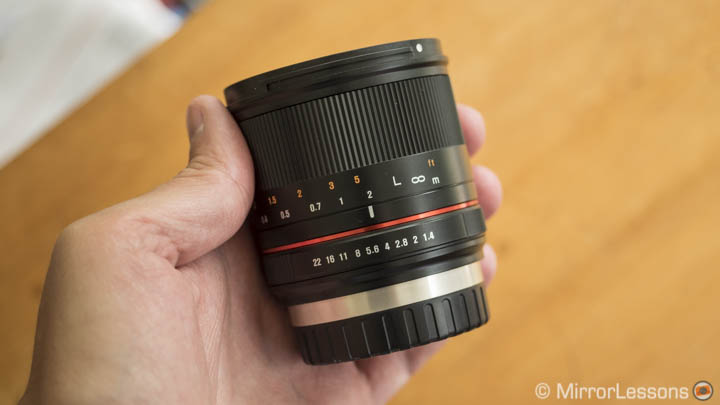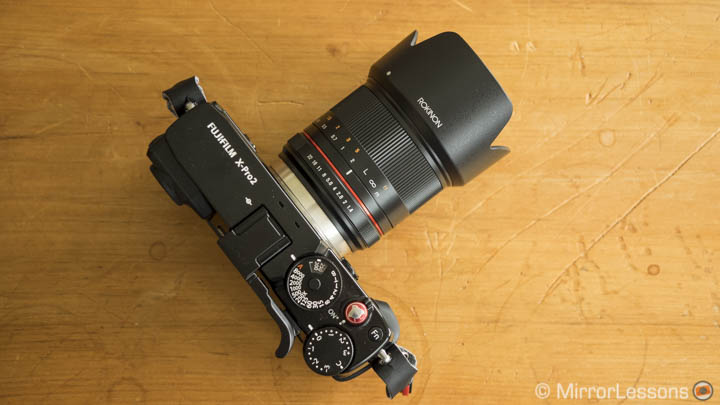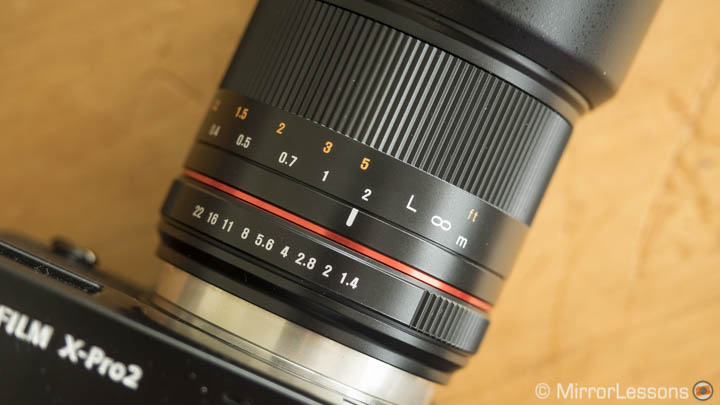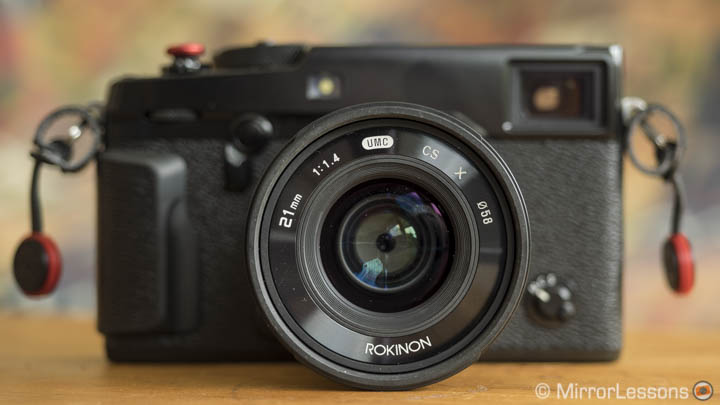Samyang has been doing an excellent job with its manual focus lenses. They provide affordable products that in many cases fulfil the “good quality / low price” requirement while sacrificing some other aspects like autofocus and electronic contacts (but that might change since the brand recently launched its first AF lenses). They also have a popular line-up of Cine lenses.
Some of these products have become very popular amongst mirrorless users. The most noteworthy example is the 12mm f/2. This time we are looking at another lens designed for APS-C systems that is appealing in many ways: it has a fast aperture, small dimensions and a competitive price.
Did the lens meet our expectations? Let’s find out.
Important note: The 21mm f/1.4 is available for Fuji X, Sony E, Canon M and Micro Four Thirds mounts. For this article, I reviewed the X-mount version but the optical quality and characteristics of the lens are the same across the board. Only the weight and length of the barrel vary slightly. In some countries the lens is sold under the Rokinon brand like the USA.



- Mount: Fuji X, Sony E, Canon M, micro four thirds
- Format coverage: APS-C
- Focal length: 21mm
- Focal length (equiv. 35mm): 31.5mm approx.
- Maximum aperture: 1.4
- Minimum aperture: 22
- Number of aperture blades: 9 circular aperture blades
- Angle of view: 69.3°
- Closest focusing distance: 28cm
- Lens configuration: 8 elements / 7 groups
- Special elements: 3 Aspherical, 1 ED elements
- Lens surface coating: Yes (Ultra Multi Coating)
- Optical Image Stabilizer: None
- Dimensions: ø64.3 x 67.9 mm
- Filter diamater: ø58mm
- Weight: 290g
Design and ease of use
The Samyang / Rokinon 21mm is a compact and lightweight lens (290g only). The build quality is good with a mix of metal and plastic. From a pure aesthetic point of view, the metal part near the mount feels somewhat like an unfinished job. A complete dark plastic cover would have given it a more discreet look. The lens lacks weather sealing of any kind.

The lens features an aperture ring that moves in 1/2 steps. It is nice to use, precise and not too loose. I can’t say the same about the focus ring: it is too smooth and can easily be turned accidentally. Despite being a mechanical ring, you don’t get the pleasing experience you would expect from a fully manual focus lens.

Another complaint is the lack of a hyperfocal scale on the barrel which is useful for street photographers. Instead there is only a focus distance scale on the focus ring. You can still do the math on your own but it would have required little effort from the Korean brand to include those additional markings on the lens.

Like most Samyang lenses, the mount on the rear lacks electronic contacts so the focal length won’t appear in the EXIF data. With Fujifilm cameras, there is a workaround whereby you input the correct focal length in the Mount adaptor settings (designed originally for the Fujifilm M-mount adaptor). On Micro Four Thirds cameras, you can use the manual focal length input for products that have sensor stabilisation. This become useful if you own more than one manual focus lens without electronic contacts.

Manual focusing on Fuji cameras is easy enough thanks to the various options (peaking, magnification and digital split image). On the X-T1 you also have the dual screen mode that is very useful. Despite the lack of a hyperfocal scale, the distance scale is precise and you know that focusing at infinity will give you sharp results for landscapes at apertures such as f/5.6 or f/8.

Unsurprisingly, the lens doesn’t have any optical stabilisation. It won’t be a problem on some Micro Four Thirds cameras but with Fujifilm or Sony APS-C products, you have to be more careful. I wouldn’t choose a slower speed than 1/25s or 1/40s depending on the specific camera used.

Through the lens: optical quality
The 21mm has an unusual field of view. Translated into 35mm format terms, it gives you approximately the same angle of view of a 31.5mm focal length. Long story short, it fits between a 28mm and 35mm equivalent lens. This makes it attractive for street photographers who might hesitate between the two classic street focal lengths. The field of view is also versatile for other uses like landscapes.

Click on the image to open the full res version

Click on the image to open the full res version
At f/1.4, the lens is a little bit soft at medium to long focus distances. Sharpness improves from f/2 and f/2.8 while the peak performance at the centre is found at f/4. Diffraction becomes noticeable from f/16.

Click to see the entire aperture sequence
[twentytwenty]


[/twentytwenty]
In the corners, the results are worse than at the centre. Sharpness only improves from f/2.8, peaking at f/5.6.
[twentytwenty]


[/twentytwenty]
The minimum focus distance is 28cm. The magnification factor is not a lot but the lens performs well in terms of sharpness at shorter focus distances. You can get good results at f/1.4 and f/2 while also taking advantage of the shallow depth of field.

Click on the image to open the full res version

Click on the image to open the full res version

Click on the image to open the full res version
The bokeh can give you good results with the right background. It isn’t the strongest point of the lens however and in some situations I find it a little bit nervous with hard edges in the out of focus elements.



The lens resists well against chromatic aberration and you might only encounter some purple fringing in the corners. Concerning flares, I only came across some tiny ghost flares and bright streaks in some situations.


Barrel distortion is contained and the difference when applying the lens profile in Lightroom is not huge. Note that the distortion of the JPG is not corrected.
[twentytwenty]


[/twentytwenty]
Vignetting is present at 1.4, 2 and 2.8 especially. Once again you can correct almost completely with the lens profile in post but not the OOC JPG.
[twentytwenty]


[/twentytwenty]
Conclusion
The Samyang / Rokinon 21mm f/1.4 is a good lens but could have been made better with a few extra gimmicks. It is light and compact, making it easy to carry around. However, the loose focus ring is annoying, and I also feel it is about time that Samyang started to include electronic contacts on lenses designed specifically for mirrorless cameras. But while I can easily overlook these shortfalls (after all, it is an affordable lens that will probably drop in price later on), the missing hyperlocal scale is more difficult to forgive given the fact that it is a fully manual lens.
It is a little soft at f/1.4 but improves from f/2. The corners are worse and improve only from f/2.8. The lens delivers excellent results from f/5.6 and the performance is good at short focus distances where you also get a decent out-of-focus rendering. The resistance to flare and chromatic aberration is excellent and the unusual field of view (close to a 31.5mm lens in full-frame terms) makes it versatile for street, reportage and landscapes.

At the moment, it is the only cheap alternative to the Fujinon 23mm f/1.4 but the latter has some relevant advantages (sharper at f/1.4, autofocus, distance scale even if very small). My feeling is that once Fuji releases the 23mm f/2, the 21mm for the X-mount will become more irrelevant.
For Sony APS-C users, it might prove more interesting because there aren’t many f/1.4 lenses for the APS-C E-mount system. It can be interesting for video work as well. That being said, there is also the Sigma 30mm f/1.4 DC DN. While it has a narrower field of view, it costs less, gives better sharpness wide open and has autofocus. However I don’t recommend it for landscapes work because the corners are softer than the centre even at f/5.6. So the Samyang remains a valid alternative for landscape photography.

On a Micro Four Thirds camera, the lens might become a more interesting option. The lack of sharpness in the corners should be less of a concern and the equivalent field of view becomes 42mm, closer to the standard focal length. Its compact size suits the system well and on Panasonic cameras it might prove useful for video too (but beware of the loose focus ring).
 What I like about the Samyang 21mm f/1.4 ED AS UMC CS:
What I like about the Samyang 21mm f/1.4 ED AS UMC CS:
- Light and compact
- Aperture ring is precise to use
- Pleasant bokeh and good sharpness when focusing close
- Good flare and CA resistance
 What I don’t like about the Samyang 21mm f/1.4 ED AS UMC CS:
What I don’t like about the Samyang 21mm f/1.4 ED AS UMC CS:
- Focus ring is too loose
- A hyperfocal scale should be present on a manual focus lens
- Shaprness becomes excellent only from f/2.8 (f/5.6 in the corners)
- No electronic contacts meaning no EXIF data recorded
